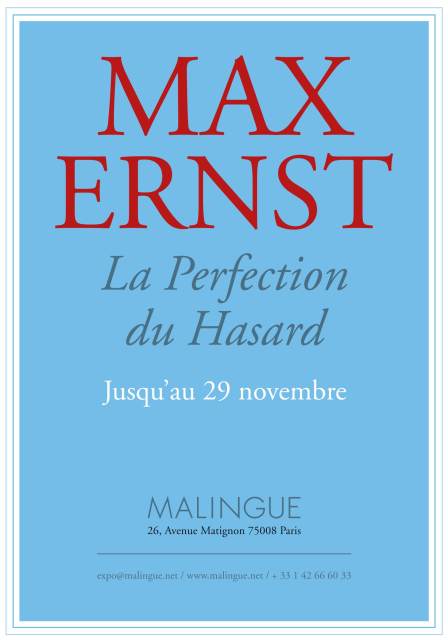In time for Europe’s celebration of the centenary of Surrealism, MALINGUE is delighted to demonstrate its ongoing attachment to this key movement in 20th-century art by holding an exhibition of carefully chosen, representative works by Max Ernst, one of the pillars of this richly diverse group.
Ernst was one of the most brilliant explorers of the wealth of possibilities to be found in chance and the unconscious, the primordial foundations of Surrealism in all its forms of expression.
The show, titled Max Ernst, La Perfection du Hasard (Max Ernst: The Perfection of Chance), enables visitors to rediscover Ernst’s skillful use of the unending opportunities offered by chance in his creations to generate opulent, fantastic images and reveal hidden truths.
After founding the Cologne Dada group in 1919, Ernst moved to Paris in 1922 and immediately became involved with the future Surrealists. Like them, he was constantly questioning his environment and the depths of his inner world. It wasn't long before he was exploring the possibilities of collage and creating multiple compositions that integrated chance as a central element of the artistic process.
Later, frottage (rubbing), grattage (scratching) and decalcomania were to become important areas of research in his work. Improbable creatures begin to appear in his creations, along with imaginary cosmic spaces and dreamlike landscapes covered in luxuriant vegetation and populated by chimerical figures.
Max Ernst was the most committed of the Surrealists when it came to finding ways of creating symbolic and narrative representations that used chance to stimulate the creative imagination. For Ernst, chance was not just a random occurrence but a powerful creative tool that invited viewers to project their own interpretations onto the imaginary worlds he created and to find personal meaning in them.
Until the end of November, Malingue presents some 20 works from the 1920s and ’30s, among them enigmatic and poetic collages, “forests” topped with brilliant suns and inhabited by magical birds (including the last “forest,” dating from 1970), “hordes” of more or less menacing figures and compositions featuring enigmatic figures and objects.
